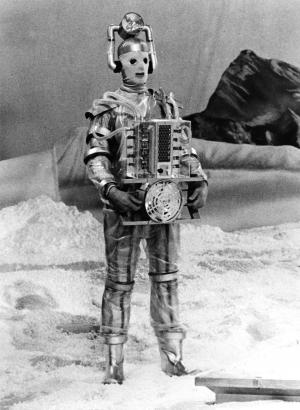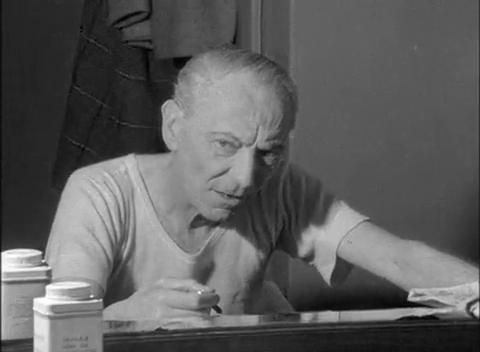Arrival of the Cybermen - Departure of a Doctor
Saturday, 8 October 2016 - Reported by Marcus

 It was fifty years ago today, on Saturday 8th October 1966, that we were introduced to one of the all-time classic monsters of Doctor Who. The Cybermen had arrived.
It was fifty years ago today, on Saturday 8th October 1966, that we were introduced to one of the all-time classic monsters of Doctor Who. The Cybermen had arrived. The Cybermen were the invention of Kit Pedler and the current story editor Gerry Davis. Pedler had been brought into the series to add a bit of scientific rigor to the scripts. A scientist from the University of London, he had already come up with the idea of the War Machines, the story which ended Doctor Who's third series.
Pedler's concept of the Cybermen came after a conversation with his Doctor wife, discussing what would happen if a person had so many prostheses that they could no longer distinguish themselves between man and machine. The story was developed with Davis, with the original Cybermen hailing from Earth's long lost sister planet, Mondas. The first Cyberman costumes were designed by Sandra Reid, who used cloth, rubber diving suits, tubing, golf balls, cricketers' gloves, and silver-painted Doc Martens boots to create the look.
 The Cybermen were an instant success and a sequel was commissioned for broadcast later in the season. They would return for three more stories during the second Doctor's era before taking a rest from the series. A one-off appearance with the Fourth Doctor was followed in 1982 by their return in the acclaimed story Earthshock. From that point on they would be a regular feature of the series with their most recent appearance being in the 2014 story Dark Water/Death in Heaven.
The Cybermen were an instant success and a sequel was commissioned for broadcast later in the season. They would return for three more stories during the second Doctor's era before taking a rest from the series. A one-off appearance with the Fourth Doctor was followed in 1982 by their return in the acclaimed story Earthshock. From that point on they would be a regular feature of the series with their most recent appearance being in the 2014 story Dark Water/Death in Heaven. The costumes may have changed over the years, the voice refined and the back story enhanced, but the concept of the Cybermen remain unchanged. The ultimate evolution of the human form, where metal and steel replace flesh and blood and inconvenient emotions are consigned to history.
On that early October evening in 1966, as viewers around the UK were enjoying the arrival of the silver menace, in a small Television studio in west London another drama was playing out. The end of an era was occurring. A much-loved actor was recording his last scenes in a popular long-running television series. William Hartnell was leaving Doctor Who.
It had been debatable whether the actor would actually make it to his last contracted episode. In the summer, Hartnell had agreed he would leave the series in the autumn, his deteriorating health making the weekly pace of the series impossible to manage. He has spent much of August holidaying in Cornwall, fishing and relaxing. In September he would return to record just one more story.
Hartnell had maintained regular correspondence with the production team throughout his break. His last story would be directed by Derek Martinus, known to Hartnell from his previous work on the series, and he was keen to involve the actor as much as possible. He wrote to him in Cornwall with the latest news about The Tenth Planet, including changes in the production week, which would now run Tuesday to Saturday each week.
We've got a very good supporting cast for you, including Bob Beatty as General Cutler. It would be very useful indeed if we could have a read through of all four episodes on the first Tuesday morning.... If we do this, it shouldn't be necessary for you to come in until after lunch on succeeding Tuesdays.
 Hartnell was delighted with the casting of Robert Beaty, an actor he knew from working on the TV series Dial 999. He was pleased with the late Tuesday start, as he needed to travel up from his home at Mayfield in Sussex. However, he was keen to show he was still very much in charge and, in a letter to the Director, he pointed out worries about the rehearsal rooms being used.
Hartnell was delighted with the casting of Robert Beaty, an actor he knew from working on the TV series Dial 999. He was pleased with the late Tuesday start, as he needed to travel up from his home at Mayfield in Sussex. However, he was keen to show he was still very much in charge and, in a letter to the Director, he pointed out worries about the rehearsal rooms being used. One important factor to me, at this boy's club, there are two Ping-Pong tables in the outer room where I like to sit and compose my thoughts, therefore, I would ask you to forbid the rest of the cast playing at these tables within our working hours
By the end of September, recording on the first two episodes of the story had been completed and the cast was assembling for the week-long rehearsal of episode three when it was clear someone was missing. William Hartnell was ill, too sick to attend. He had to be quickly written out of the episode, with story editor Gerry Davis rewriting the script to render the Doctor unconscious for the entire episode. Derek Martinus wrote to reassure the actor
Please don't worry about the show. Gerry has been very clever and managed to write around you. Everybody sends their warmest regards and we all hope you will be fit to do battle one last time
Hartnell did return the following week and after the four-day rehearsal, the team assembled at Studio 1, Riverside studios on Saturday 8th October where he would record his final episode. By far the most complex challenge of the day was to record the transformation of the First Doctor into the Second, so this was taped first, and Doctor Who history was written between 6.30pm to 7.00pm when the first regeneration in the series history was recorded. Anneke Wills remembers the event
The meeting between Bill and Pat was quite extraordinary. It was like two gentlemen very politely meeting each other. Pat was suitably humble and it was very pointed moment. I think Bill's ego was quite tickled by the fact that he was being replaced by someone of the caliber of Pat Troughton
The woman charged with achieving the transformation was Vision Mixer Shirley Coward The first I knew of the regeneration was when I arrived in the studio that day and they said we are going to change William Hartnell into Patrick Troughton. Nobody was exactly sure how they were going to do it, so it was a matter of the studio engineers and the cameramen just trying out things
After a supper break, the rest of the episode was recorded from 8.00pm to 10.15pm, incurring a slight overrun. And with that, the Hartnell era was over. The last scenes had been recorded, a new Doctor was now installed. A small farewell party was held at producer Innes Lloyd's flat and then Lloyd drove him home to Sussex.
William Hartnell would live until 1975, but his progressive disease meant he would not work regularly again. He had a small run in a pantomime the following Christmas playing Buskin the Fairy Cobbler in Puss In Boots. He would briefly return to Doctor Who in the 1972 story The Three Doctors, but by then his health was so poor all his scenes were pre-filmed in one day.
Today the character he created is known and loved around the world. His legacy lives on.




















